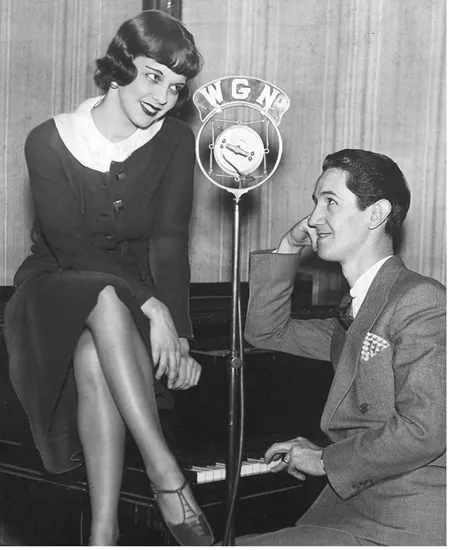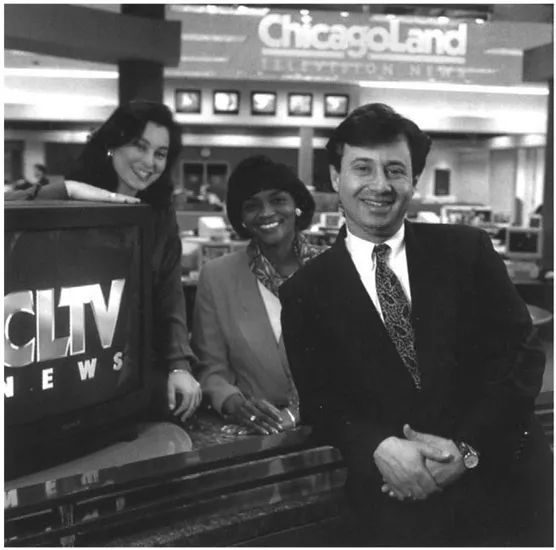![]() II
II
Convergence in Action![]()
4
Tribune Company: A Convergence Pioneer Since the 1900s
Clarence Darrow and the Scopes Monkey Trial may be hidden in the recesses of legal and social history, but accounts of media history during that period should include coverage of the trial by the Chicago Tribune and its sister radio station, WGN. The call letters WGN stand for “World’s Greatest Newspaper,” and that is exactly what the Tribune, or the late Colonel Robert McCormick, wanted the public to think whenever reading its pages in the heady days of the 1920s. Fast forward to the 21st century, and you might wonder what this has to do with convergence—everything when it comes to Tribune Company. The cross-promotion of the radio station and newspaper across the two mediums in the 1920s was an early form of convergence nearly 70 years before it was the phenomena that traverses through media organizations seeking to integrate the potential and promise of technology into their operations. The significance of WGN is apparent in the “About Tribune History” link on the corporate Web site.
Chicago’s WGN Radio (720 AM) went on the air in 1924, its call letters reflecting the Chicago Tribune’s renowned slogan, “World’s Greatest Newspaper.” The station was an innovator from the start. It was first to broadcast the World Series, the Indianapolis 500 and the Kentucky Derby, and broke new ground by introducing microphones in the courtroom during the famous 1925 Scopes “monkey trial” in Tennessee. Today, Tribune’s original broadcast property is a 50,000-watt Midwest powerhouse. (Tribune.com, 2004, par. 5)
Chicago Tribune Senior Vice President and Executive Editor, Ann Marie Lipinski, stated that an old Tribune photograph of the Scopes Trial with alone picture of a WGN radio microphone is one of her favorite pictures and a testament to Colonel McCormick as a “great technological visionary” (Lipinski, 2000, p. 9) (see Fig. 4.1). What might have appeared as excessive newspaper publicity in those days was really interesting foresight into what Tribune Company has come to symbolize in the age of convergence. Tribune Tower sits as a beacon on Michigan Avenue towering over the nearby Chicago River with its plethora of drawbridges threaded along the river. The Tower is more than a landmark—it is home to a 158-year-old media tradition that includes newspapers, TV, radio, and cable Superstation WGN. The Chicago Cubs Major League Baseball team provides a bounty of programming, with 70 games aired each year (“Swinging,” 2004). Superstation WGN celebrated its 25th anniversary in 2004. Table 4.1 highlights significant aspects of Superstation WGN.
Traditional Convergence Pioneer
Chicago-based Tribune Company is a traditional convergence pioneer dating to the early 1900s. It is traditional in the sense that the Chicago Tribune newspaper is a historical print icon that capitalized on its “synergies” with WGN radio before such terms as synergy and convergence were the well-known vernacular in the industry. Tribune was chosen for this case study based on its tradition of utilizing all of its business units to cross-promote and support efforts to get the brand before the public. It is a laboratory for convergence because it blends its business units in Chicago in strategic ways that take advantage of its position of cross-ownership of media in a major market. The analytical approach for the three case studies in Part II of this book is explanation building—an inductive approach that uses the collected data to build an explanation about the case (Haas, 2000). Tribune employees quoted in this
Fig. 4.1. This undated photo illustrates a broadcast session at WGN Radio. Photo courtesy of Tribune Company.
chapter were interviewed at different intervals starting in 2002 and 2004. This case study explicates specific elements of Tribune operations in Chicago to illustrate present-day efforts to move convergence forward by utilizing the resources across business units.
Table 4.1 Superstation WGN at 25
| Superstation WGN: 25 years of programming, 1979–2004 |
| •100% analog distribution |
| •50 to 60 million viewers |
| •70 Chicago Cubs games aired each year |
| •700-title movie library |
| •First original programming to debut in 2005 |
| •Local counterpart WGN-TV Chicago |
First, it most be noted that Tribune Company was grandfathered into the 1975 Federal Communications Commission (FCC) cross-ownership act because it owned its properties before the rule was enacted. Therefore, the company has been rewarded by the opportunity to own a number of successful media properties in the same market. The FCC attempts in 2003 to lift the cross-ownership ban were halted the following year by a federal court in Philadelphia. Tribune’s efforts to capitalize on crossownership of properties in the company’s other markets have been limited because of the ruling. Therefore, this case study centers on the company’s Chicago operations where cross-ownership of media properties has flourished.
Tribune Company’s business units in the city include the Chicago Tribune, WGN radio and TV, CLTV regional cable, chicagotribune.com, Metromix.com, and the Chicago Cubs. The office of Intergroup Development is handled out of Chicago, and Tribune Interactive incorporates all of the Web sites for Tribune. Other media holdings are discussed later, but of note is Tribune’s presence in the top three media markets, now owning Times Mirror’s the Los Angles Times and New York Newsday and the obligatory broadcast and electronic holdings in those markets. The corporate parent’s reach extends across print, broadcast, cable, and the Internet. Table 4.2 contains a list of Tribune Company’s holdings compiled from corporate Web sites and Columbia Journalism Review’s “Who Owns What” (Columbia, 2004; Tribune.com, 2004).
Table 4.2 Tribune Company
| Newspapers |
| Chicago Tribune, Newsday (Long Island, NY), Los Angeles Times, Baltimore Sun, South Florida Sun-Sentinel, Orlando Sentinel, The Hartford Courant, The Morning Call (Allentown, PA), Daily Press (Hampton Roads, VA), The Advocate (Stamford, CT), Greenwich Time (CT), La Opinion (Los Angeles), Exito (Chicago), Hoy (New York), El Sentinel (Orlando) |
| Broadcast |
| WGN - Chicago, WPIX - New York, KTLA - Los Angeles, WPHL -Philadelphia, WLVI - Boston, KDAF - Dallas, WATL - Atlanta, KHWB - Houston, KCPQ - Seattle, KTWB - Seattle, WBZL - Miami - Ft. Lauderdale, KWGN - Denver, KTXL - Sacramento, WXIN - Indianapolis, WTTV - Indianapolis, KSWB - San Diego, WTIC - Hartford/New Haven, WTXX- Hartford, WXMI - Grand Rapids, WGNO - New Orleans, WNOL - New Orleans, WPMT -Harrisburg, WBDC - Washington, WEWB - Albany, KPLR - St. Louis, KWBP - Portland, WB Network, Tribune Entertainment |
| Cable |
| WGN, Chicago Land Television (CLTV), Central Florida News 13 |
| Radio |
| WGN-AM (Chicago) |
| Other |
| Chicago Cubs, Tribune Media Services, Classified Ventures (partial), Brass Ring, Zap 2 It, BlackVoices.com, Chicago magazine, CareerBuilders.com, Apartments.com, Cars.com, New Home Network, Homespace.com, Calendarlive.com, Metromix.com, SouthFlorida.com, 7Cities.com, HRtickets.com, ChicagoSports.com, Go2orlando.com |
Convergence in the Newsroom 1993
A modern-day version of convergence arrived at Tribune in 1993: CLTV, the Chicago area’s first and only 24-hour all-news cable channel, aired its first broadcast. The Chicago Tribune’s sister station, CLTV, quickly became a model for multimedia content sharing and cross-promotion throughout Tribune Company. Today, Tribune newspapers aggressively partner with the news operations of Tribune TV stations in their markets or with non-Tribune broadcasters, including local radio stations (Tribune.com, 2004, par. 17).
The photo (Fig. 4.2) illustrates the author’s entry into the convergence world at the Chicago Tribune in 1993, when a converged newsroom opened in one of its news bureaus. The DuPage County newspaper bureau was relocated from Hinsdale to Oak Brook, Illinois, to share facilities with the staff of the new CLTV cable station and an advertising staff for the county. As an assistant bureau chief, the author worked with the bureau chief to acclimate print reporters to an organizational cultural change that included cooperation with the newspaper’s sister broadcaster. A half-circle news desk separated the cable operations from the newspaper bureau. The expectation, however, was that resources and facilities would be shared. Print reporters were expected to collaborate on news coverage with the cable journalists in the background on stories, on-camera interviews, and so on. This did not sit well with many of the print journalists who were indoctrinated with the philosophy that they provided the most in-depth coverage through the printed word. Broadcasters were believed to be visual and offer snippets of information to meet 30-second sound bites or limited airtime. Such notions still exist, but have evolved over the years, and many print journalists in Chicago comfortably collaborate and have adapted to the fusion of print, broadcast, and the Internet.
Structure of Chicago Operations
The convergence structure in Chicago is detailed in an internal document describing multimedia journalism operations. This document details the organization of units that led to the process of convergence. Inside Tribune Tower, a TV platform was set up in the fourth-floor newsroom, and seven other locations throughout the tower were wired for live camera and studio equipment. Other outlets included a radio booth, Intergroup Operations for broadcasters, and chicagotribune.com. Properties on the lower level of the Tower are Metromix.com, Blackvoices.com, and Sports.com, and offsite in a western suburb bureau office is CLTV cable.
Fig. 4.2. The author (center), Jill Rosengard, CLTV assignment editor, and Michael Adams, director of news and programming, in the joint CLTV and Chicago Tribune Oak Brook bureau in 1993.
Daily, breaking, and suburban news is covered across platforms and often cross-promoted. In one example of broadcast to Internet flow, WGN-TV meteorologist, Tom Skilling, prepares information for the weather page for the Chicago Tribune and provides a column answering questions posed by the audience. For special projects and investigation, WGN-TV shares content with the newspaper, WGN radio, CLTV, and chicagotribune.com. In addition, audio from WGN radio can be linked to Internet sites. ChicagoSports.com takes sports coverage online and interactive and enhances the traditional coverage in the newspaper’s Sports section. The online site includes critics, commentaries, and special projects such as quizzes that increase interactivity. Sports columnists also tape shows for CLTV cable. The Features department at the newspaper has capitalized on the convergence process in numerous ways. Columnists regularly appear on WGN. Movie, theater, and TV reviews are regular features for CLTV cable and WGN. The newspaper reviewers step up their coverage by integrating broadcast and interactive components to newspaper coverage, such as coupling a music review with video and concert clips to appear on Tribune broadcast outlets. The audience has a dynamic experience that allows entry at any point to the content.
The business coverage is lifted from the pages when newspaper columnists appear on a weekly CLTV business show, such as Jobs columnist Carol Kleiman providing career-coaching advice in print and broadcast. A daily business analysis is provided by a newspaper reporter on CLTV. The flow of content from Internet to broadcast and print has an extra with Metromix.com, the entertainment site for the metropolitan Chicago area that started in 1997. The award-winning site is targeted to the 18- to 35-year-old demographic looking for the latest trends, where to go, and what to do in the Chicago area. Metromix.com has continued to build its relationship with the audience, creating forums for interactivity by posting critiques from the audience. Extensions of the brand include Metromix Minute, which previews the latest happening on the WGN morning and noon news. There is now a Metromix the TV Show on CLTV cable that cross-promotes with the Web site and extends the brand even more. Blackvoices.com, a Web site devoted to African-American issues and interests, also has a segment on CLTV. Reports from chicagotribune.com are also provided weekday mornings on WGN radio.
One example of information flow is a member of the Electronic News group participating ...


